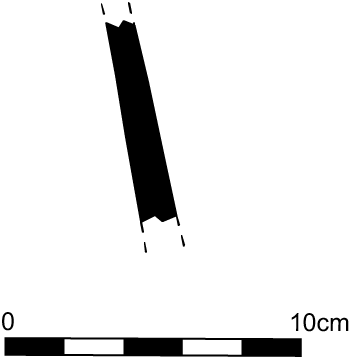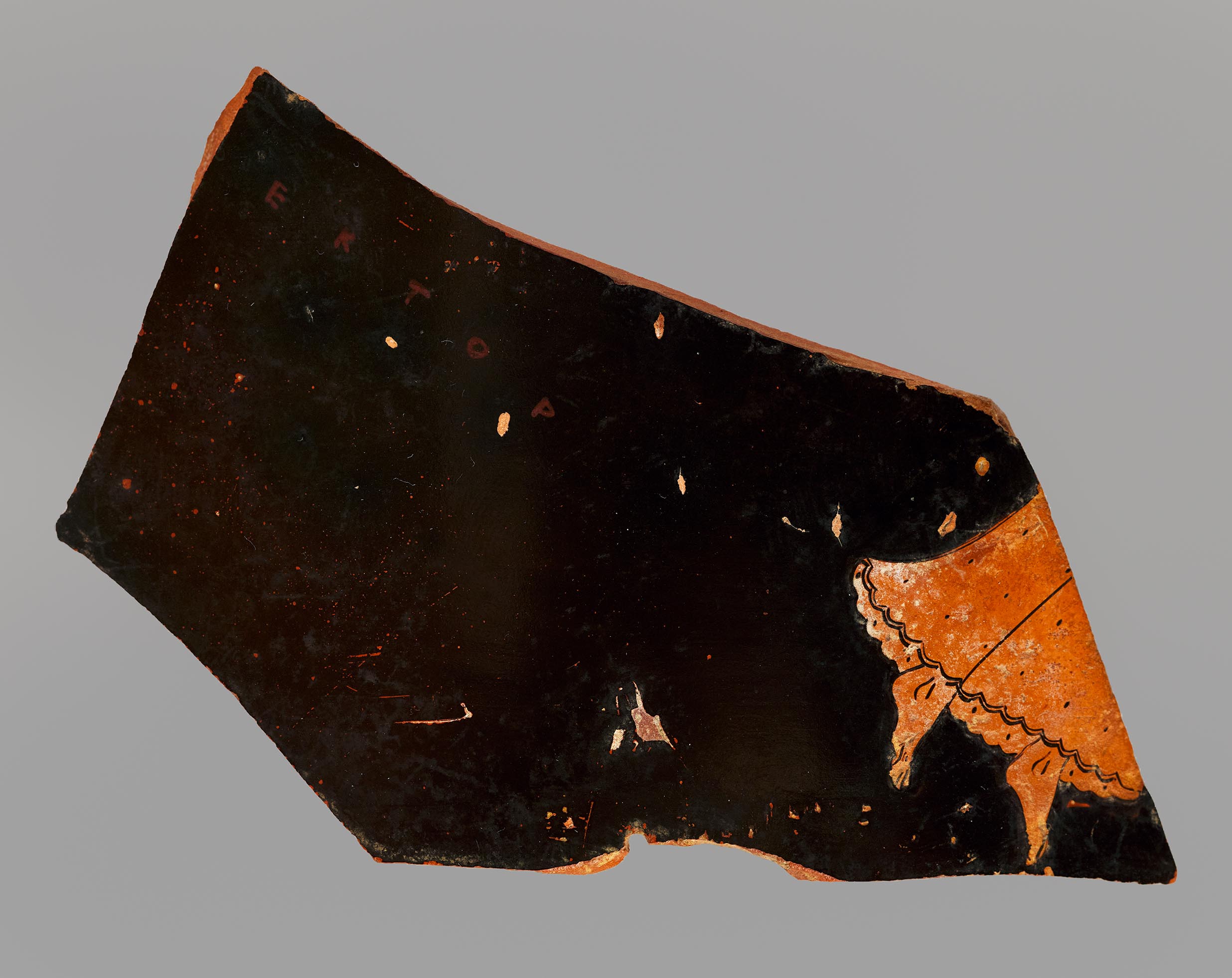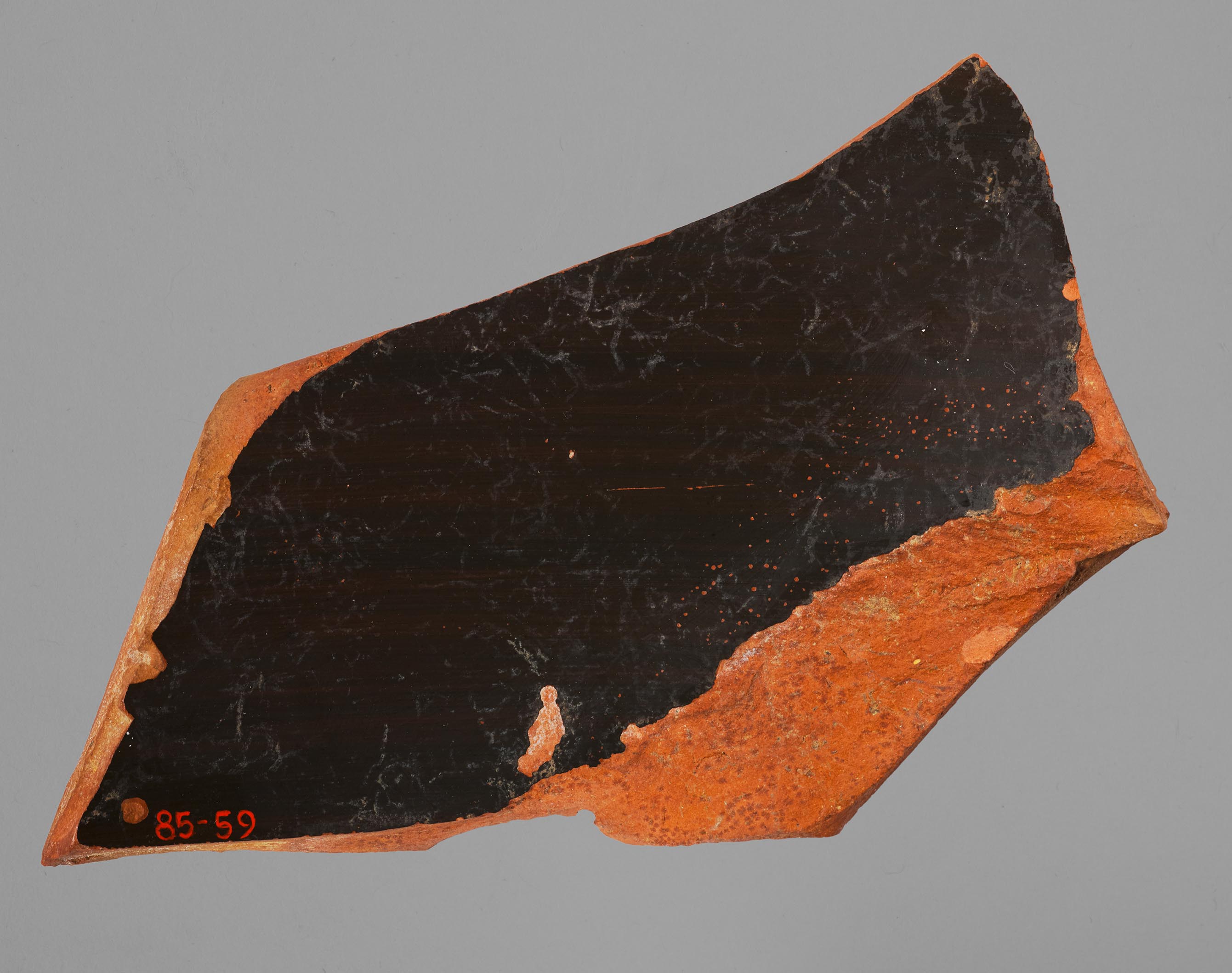Provenance
1985, gift, Dietrich von Bothmer (Centre Island, NY) to Princeton University. A label in von Bothmer’s hand, now removed, says, “ex N.K. 1981,” possibly alluding to the Geneva dealer Nicholas Koutoulakis and the year that von Bothmer acquired the fragment.
Shape and Ornament
Single fragment from the body. Interior black. No ornament preserved.

Subject
Nike, flying. At the right, the fragment preserves the feet and lower legs of Nike flying to the right. She wears an ankle-length chiton, with dotted decoration and a double scalloped hem.
The inscription EKTOP to the left of Nike indicates the presence of Hektor, although none of his figure is preserved.
Attribution and Date
Attributed to the Berlin Painter [D. von Bothmer]. Circa 490 BCE.
Dimensions and Condition
12.2 × 8.5 cm; thickness 1.0 cm. Broken on all sides. Scattered abrasion overall. Black slip slightly mottled, in particular by the left edge of the fragment. Drill hole from an ancient repair preserved on the lower edge.
Technical Features
Preliminary sketch. Relief contour. Accessory color. Red: inscription. Dilute gloss: dots on Nike’s chiton.
Inscriptions
To the left of Nike, EKTOP.
Bibliography
Abbreviation: Princeton RecordRecord of the Princeton University Art Museum. (1942– ). 45 (1986): 38 [not illus.]; J. M. Padgett, “Fragment of a Red-Figure Calyx-Krater,” in Abbreviation: Padgett, Berlin PainterJ. M. Padgett, with contributions by N. T. Arrington et al. The Berlin Painter and His World: Athenian Vase-Painting in the Early Fifth Century B.C. Princeton, 2017, 264.
Comparanda
The bibliography on the Berlin Painter is extensive. See, in particular, Abbreviation: ABVJ. D. Beazley. Attic Black-Figure Vase-Painters. Oxford, 1956 407–9; Abbreviation: ARV2J. D. Beazley. Attic Red-Figure Vase-Painters. 2nd ed. Oxford, 1963 196–216, 1633–36, 1700–1701; Abbreviation: ParalipomenaJ. D. Beazley. Paralipomena: Additions to Attic Black-Figure Vase-Painters and to Attic Red-Figure Vase-Painters. Oxford, 1971 177, 341–46, 510, 519–20; Abbreviation: BAdd2Carpenter, T. H., ed. 1989. Beazley Addenda: Additional References to ABV, ARV2, and Paralipomena. 2nd ed. Oxford: Published for the British Academy by Oxford University Press. 106, 190–97; J. D. Beazley, “The Master of the Berlin Amphora,” Abbreviation: JHSJournal of Hellenic Studies 32 (1912): 354–69; C. M. Robertson, “The Origins of the Berlin Painter,” Abbreviation: JHSJournal of Hellenic Studies 70 (1950): 23–34; C. Boulter, “The Berlin Painter at Corinth,” Abbreviation: HesperiaHesperia: The Journal of the American School of Classical Studies at Athens 35 (1966): 310–19; Beazley, The Berlin Painter (Mainz, 1974); C. Cardon, “The Berlin Painter and His School” (PhD diss., Institute of Fine Arts, New York University, 1977); R. Blatter, “Eine Nike des Berliner Malers,” Abbreviation: AntWAntike Welt: Zeitschrift für Archäologie und Kulturgeschichte 12.3 (1981): 59; G. Barbiere, “Due vase del Pittore di Berlino da Vibo Valentia,” Abbreviation: BdA‘Bollettino d’'arte’ 67 (1982): 61–66; D. Kurtz, The Berlin Painter (Oxford, 1983); C. M. Robertson, “The Berlin Painter at the Getty Museum and Some Others,” in Abbreviation: GkVasesGetty 1Frel, J., and S. K. Morgan, eds. 1983. Greek Vases in the J. Paul Getty Museum. Occasional Papers on Antiquities 1. Malibu: J. Paul Getty Museum., 55–72; Abbreviation: Robertson, Art of Vase-PaintingM. Robertson, The Art of Vase-Painting in Classical Athens. Cambridge, 1992, 66–83; M. Moore, “The Berlin Painter and Troy,” in Abbreviation: GkVasesGetty 6True, M., and M. L. Hart, eds. 2000. Greek Vases in the J. Paul Getty Museum. Vol. 6. Occasional Papers on Antiquities 9. Malibu: J. Paul Getty Museum., 159–86; id., “Satyrs by the Berlin Painter and a New Interpretation of His Name-Piece,” Abbreviation: AntKAntike Kunst 49 (2006): 17–27; Abbreviation: Padgett, Berlin PainterJ. M. Padgett, with contributions by N. T. Arrington et al. The Berlin Painter and His World: Athenian Vase-Painting in the Early Fifth Century B.C. Princeton, 2017. The last contains an up-to-date and thorough bibliography. Although fragmentary, several features of the drawing allow for an attribution of Princeton’s fragment to the Berlin Painter, including the thin and flowing line, the rendering of the ankles, and the chiton. For the rendering of the ankles, cf., inter alia, Berlin 1965.5 (Abbreviation: ParalipomenaJ. D. Beazley. Paralipomena: Additions to Attic Black-Figure Vase-Painters and to Attic Red-Figure Vase-Painters. Oxford, 1971 345.184 bis; Abbreviation: BAPDBeazley Archive Pottery Database. http://www.beazley.ox.ac.uk 352486); London E 266 (Abbreviation: ARV2J. D. Beazley. Attic Red-Figure Vase-Painters. 2nd ed. Oxford, 1963 198.21, 1633; Abbreviation: BAPDBeazley Archive Pottery Database. http://www.beazley.ox.ac.uk 201829). For the dotted chiton with a double scalloped hem, cf. Oxford 1912.1165 (Abbreviation: ARV2J. D. Beazley. Attic Red-Figure Vase-Painters. 2nd ed. Oxford, 1963 208.144; Abbreviation: BAPDBeazley Archive Pottery Database. http://www.beazley.ox.ac.uk 201963); Medusa on Munich SH 2312 (Abbreviation: ARV2J. D. Beazley. Attic Red-Figure Vase-Painters. 2nd ed. Oxford, 1963 197.11; Abbreviation: BAPDBeazley Archive Pottery Database. http://www.beazley.ox.ac.uk 201820). As noted by Padgett (“Fragment of a Red-Figure Calyx-Krater,” 264), although the Berlin Painter drew the goddess Nike on numerous occasions, none exactly parallel the details of the Nike on Princeton’s fragment. The closely spaced feet of the goddess are paralleled on the oinochoe in Berlin (supra), but there the goddess’s chiton is rendered with folds in relief line: cf. also, for the position of the feet of the flying goddess, Oxford AN 1890.30 (Abbreviation: ARV2J. D. Beazley. Attic Red-Figure Vase-Painters. 2nd ed. Oxford, 1963 203.100; Abbreviation: BAPDBeazley Archive Pottery Database. http://www.beazley.ox.ac.uk 201908). The Berlin Painter also depicted flying goddesses with a wider stance, perhaps indicative of more rapid flight: cf. Iris, including the drawing of the foot, on Paris, Louvre G 192 (Abbreviation: ARV2J. D. Beazley. Attic Red-Figure Vase-Painters. 2nd ed. Oxford, 1963 208–9.160, 1633; Abbreviation: BAPDBeazley Archive Pottery Database. http://www.beazley.ox.ac.uk 201979).
Considering the small size of the figure of Nike and what would have been the large space available for figural decoration on the complete calyx-krater, it is likely that Nike was part of a larger narrative scene. The inscription EKTOP to the left of Nike suggests that the Trojan prince Hektor was depicted on the left side of the scene. Nike thus flies away from the hero, suggesting his defeat. Nike may then be flying toward Hektor’s killer, Achilles, to crown him with a wreath of victory. For a similar composition by the Pan Painter, this time with Achilles defeating Penthesilea, cf. Cambridge GR.3.1971 (Abbreviation: ARV2J. D. Beazley. Attic Red-Figure Vase-Painters. 2nd ed. Oxford, 1963 550.3; Abbreviation: BAPDBeazley Archive Pottery Database. http://www.beazley.ox.ac.uk 206278). Although the Berlin Painter was not particularly fond of depicting Trojan themes, he did so on several occasions, including another duel between Achilles and Hektor, in which the figures are identified by inscriptions, on London E 468 (Abbreviation: ARV2J. D. Beazley. Attic Red-Figure Vase-Painters. 2nd ed. Oxford, 1963 206.122, 1633; Abbreviation: BAPDBeazley Archive Pottery Database. http://www.beazley.ox.ac.uk 201941). The two heroes may also duel on a stamnos by the Berlin Painter in Munich, although inscriptions do not aid identification in this case: Munich J 421 (Abbreviation: ARV2J. D. Beazley. Attic Red-Figure Vase-Painters. 2nd ed. Oxford, 1963 207.137, 1633; Abbreviation: BAPDBeazley Archive Pottery Database. http://www.beazley.ox.ac.uk 201956). In general, Trojan themes by the Berlin Painter follow his proclivity for simple compositions, with only the figures essential to the narrative depicted. On Princeton’s krater, the scene was perhaps limited to just the fallen Hektor and triumphant Achilles, with Nike intervening between the two. For this interpretation of the fragment, see Padgett, “Fragment of a Red-Figure Calyx-Krater,” 264. For Trojan themes within the work of the Berlin Painter and the painter’s iconographic connections with the Pioneers, see Moore, “The Berlin Painter and Troy,” 178–83.

